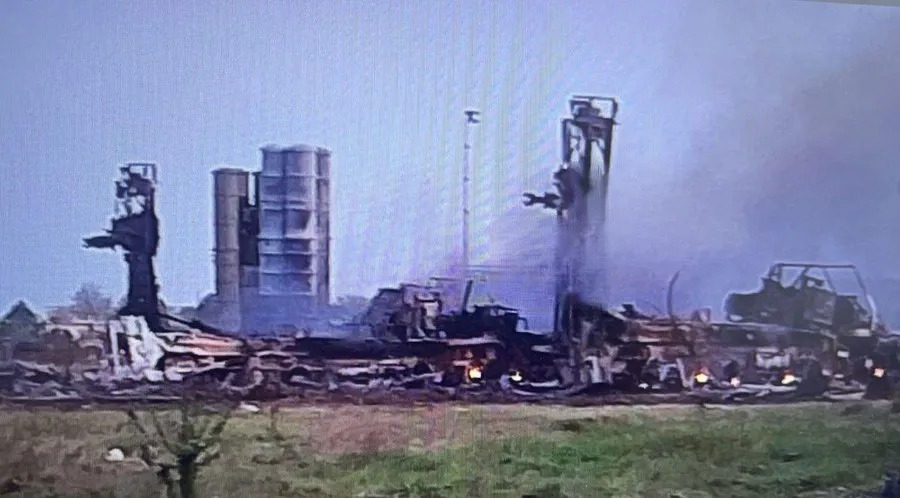Russia lost a S-400 surface-to-air missile (SAM) battery in northern Crimea on Wednesday (April 17) to a Ukrainian strike. Reports claim the attack was a result of a strike from the MGM-140 Army Tactical Missile System (ATACMS), fired from the High-Mobility Artillery Rocket System (HIMARS).
The loss has dealt a severe blow to Russia’s air defense cover from the Ukrainian F-16s, where the S-400 was expected to play a major role in shooting them down, as was analyzed in earlier EurAsian Times reports.
Interestingly, earlier this month, Russia conducted unusual warhead-free inert missile firings from the same location—around the Dzhankhoi (Dzhankoy) air base.
Confused Ukrainian officials later concluded that the Russians were aiming to finalize the placement of their S-400s for optimal radar coverage before the F-16s reached the Ukrainian Air Force (UAF).
F-16s Job Becomes Easier?
Whether it was this Russian exercise that helped Ukraine identify and target the S-400 is not known. But it would not be difficult to conclude that the practice did play a role in the attack. Nevertheless, with the loss of the three A-50U Airborne Warning Control Systems(AWACS) and an S-400, Russia’s ability to counter the F-16s has certainly been impeded.
The Russian Aerospace Forces (RuAF) nevertheless retains the significant capability to shoot down F-16s, as it has only lost 10 percent of its fleet and has sophisticated fighters like the Su-35S, Su-30SM, and MiG-31.
It is likely to push its land offensive and take more areas in the separatist Russian-speaking Donbas region in the coming months to nullify any tactical successes the F-16s might lend Ukraine. Since last year, leading Western analysts have also assessed that the F-16s will not be a game-changer in Ukraine.
‘S-400 Destroyed’
Many war reporting handles allied to Ukraine showed a pixelated image of burning debris from what they “claimed” was an “S-400 battery” in Dzhankhoi, “northern Crimea.” The image appears to be a still from a video or possibly a picture taken from screen footage of the burning system. The destroyed components appear to be mast-mounted radars and the trucks they are placed on.

Around four to six cylindrical silos on Tele-Erector Launchers (TEL), however, seem to be intact. ‘OSINTtechnical’ claimed that Ukraine used a “pair of MGM-140 ATACMS.” The missile can reach ranges of up to 300 km. Artur Rehi, a reserve soldier in the Estonian military who analyzes the war, said Dzhankhoi is home to RuAF’s 39th Helicopter Regiment, part of the 27th Mixed Aviation Division under the 4th Air Force.
Militarnyi, a semi-official website that reports development from the battlefield, put the number of MGM-140 ATACMS at “two”. “Three launchers and a radar of the S-400 Triumph air defense system were destroyed,” the report added.
Other Ukrainian media said the strikes were a “joint operation” between the Armed Forces of Ukraine (AFU) and the Main Directorate of Intelligence (SBU). That report, however, contradicted the ATACMS role and claimed the use of “modernized Soviet weapons.”
The SBU (Security Service of Ukraine) involvement, meanwhile, suggests Ukraine has been using the small anti-Russian camp in Crimea—called the Crimea Underground—for on-location target verification, surveillance, and damage assessment. Rybar, a leading Kremlin-aligned military analysis forum, said that “around 12 ATACMS operational-tactical missiles” probably launched from Ukraine’s Kherson region were used in a two-phase strike.
An initial wave of seven missiles armed with cluster munitions struck the airfield to destroy aircraft and cause casualties. This was followed by a second wave of five missiles armed with high explosive warheads targeted fuel reserves and ammunition storage, Rybar added.
Other Russian milbloggers, too, claimed use of the US-made MGM-140 ATACMS but added that US reconnaissance aircraft assisted Ukrainian planners, particularly the MQ-4B Global Hawk surveillance drone. EurAsian Times has, however, not been able to independently verify the use of the MGM-140 ATACMS.
‘Range-Finding’
A report on Politico earlier this month touched upon how Russian ground offensives were putting Ukraine “at great risk of its frontlines collapsing.” “And according to high-ranking Ukrainian military officers who served under General Valery Zaluzhny—the commander-in-chief of Ukraine’s armed forces until he was replaced in February—the military picture is grim,” the report added.
While talking about the delay in receiving jets like the F-16, which were “needed in 2023 (but not) right in 2024,” Ukrainian military officials said Russia was preparing to “counter them.” In the last few months, AFU “noticed” missiles being fired by the Russians “from Dzhankoy in northern Crimea, but without the explosive warheads.” “We couldn’t understand what they were doing, and then we figured it out: They’re range-finding,” a Ukrainian officer said.
The officer explained that Russia was “calculating” where best to deploy its S-400 missile and radar systems to “maximize the area they can cover to target the F-16s, keeping them away from the front lines and Russia’s logistical hubs.” Russia did not specify which missile it used for this range-finding exercise.
AFU officials implied how minor tactical victories before Russia would not turn the strategic tide of the war. Largely due to a “much greater weight in numbers and the guided aerial bombs that have been smashing Ukrainian positions for weeks now,” Russia will likely be able to “penetrate the front line and to crash it in some parts.”
- The author can be reached at satamp@gmail.com
- Follow EurAsian Times on Google News